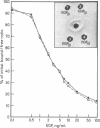Abstract
Epidermal growth factor (EGF) has been isolated from acid extracts of C57BL6/J mouse submaxillary glands by using hydrophobic chromatography. High yields of EGF in large amounts (10 mg) can be isolated reliably from the acid extract of the glands in less than 4 hr. The reverse-phase HPLC techniques used to purify the EGF initially yielded what appeared to be a single homogeneous EGF molecule. However, ion pairing reagents (e.g., heptafluorobutyric acid) altered the chromatographic properties, revealing two distinct species: EGF-alpha and EGF-beta. The apparent molecular weights, isoelectric points, and antigenic properties of EGF-alpha and EGF-beta were identical, and both forms stimulated a mitogenic response in 3T3 cells. Analysis of different preparations of purified EGF (commercial and experimental) indicated the presence of EGF-alpha and EGF-beta in constant proportion. Previous EGF binding studies must have used mixtures of 125I-labeled EGF-alpha and 125I-labeled EGF-beta. The two molecules appear to compete for an identical receptor on the cell surface.
Full text
PDF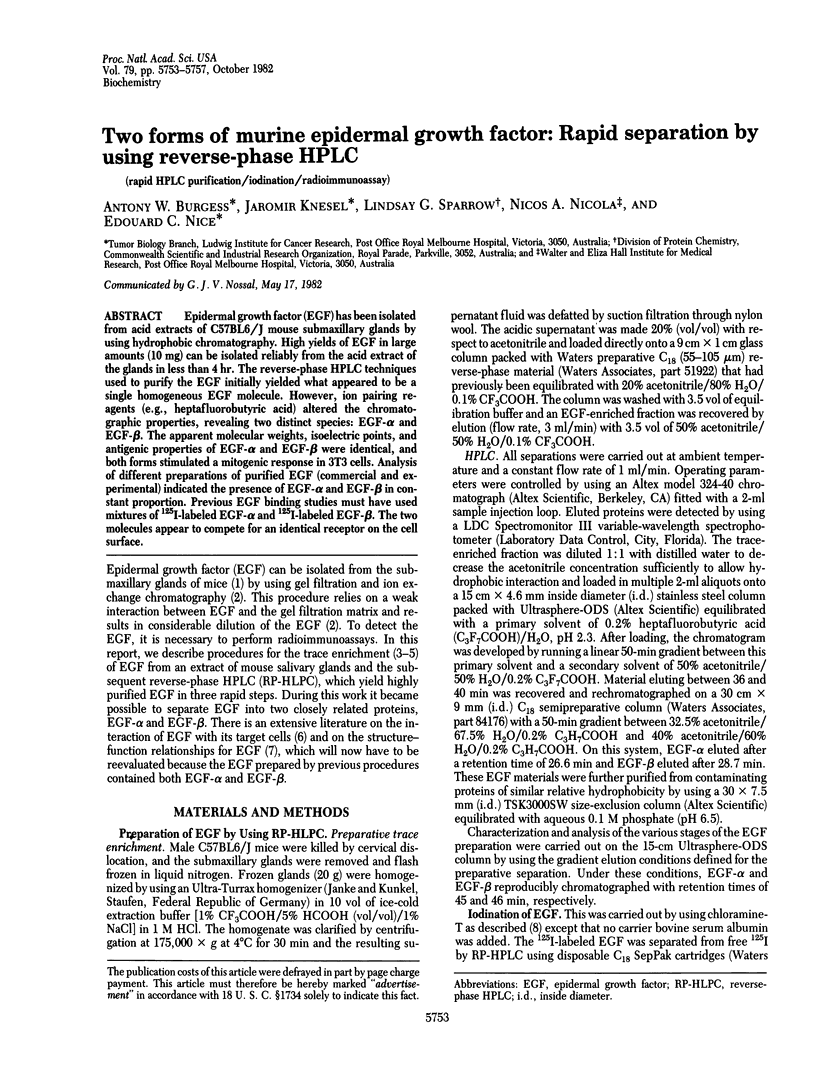
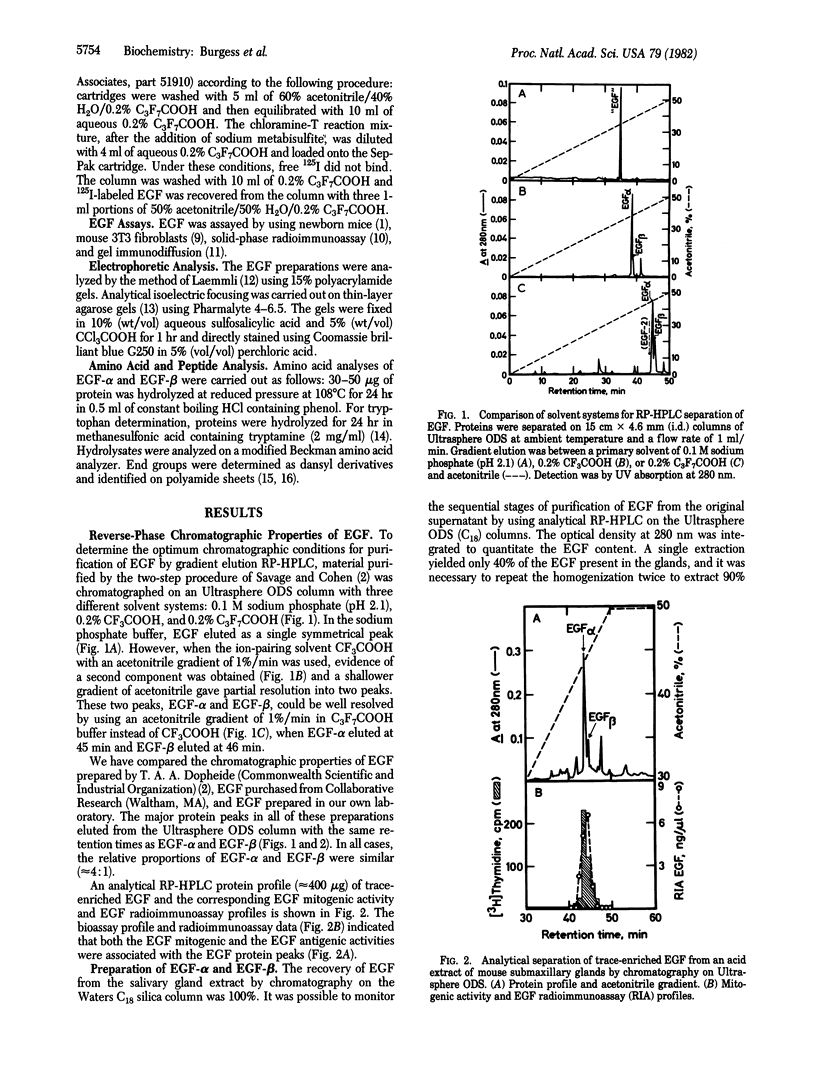
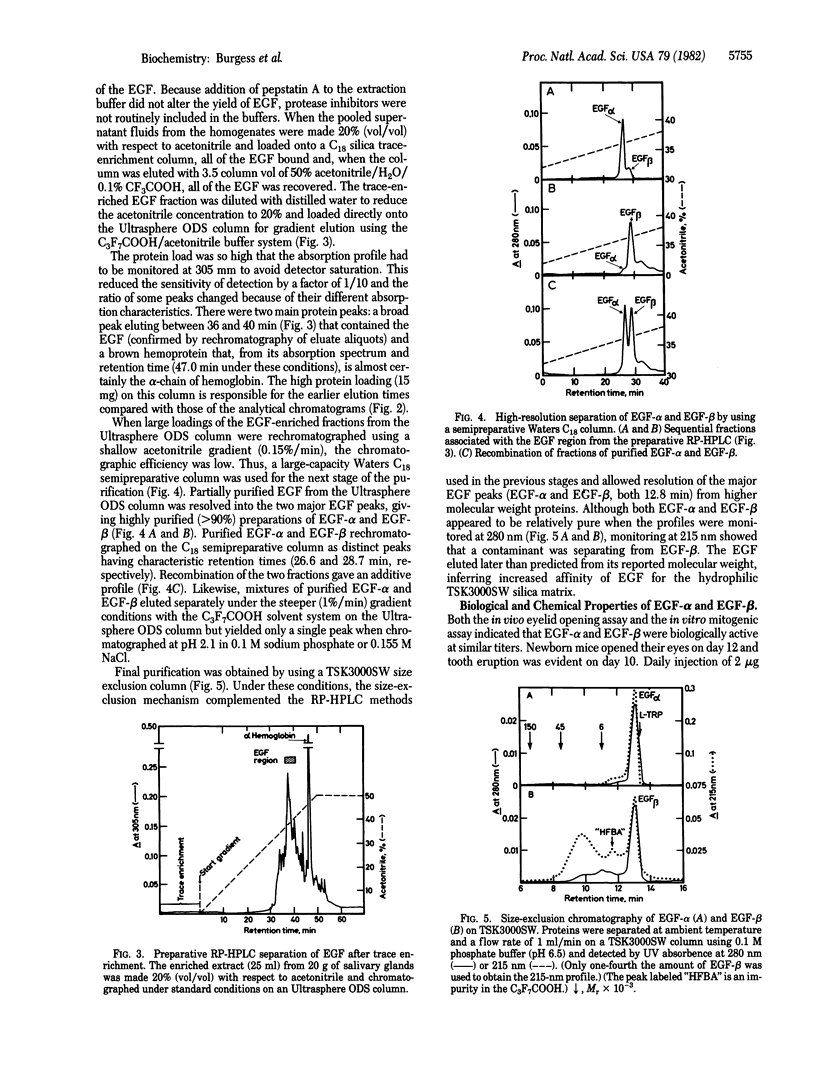
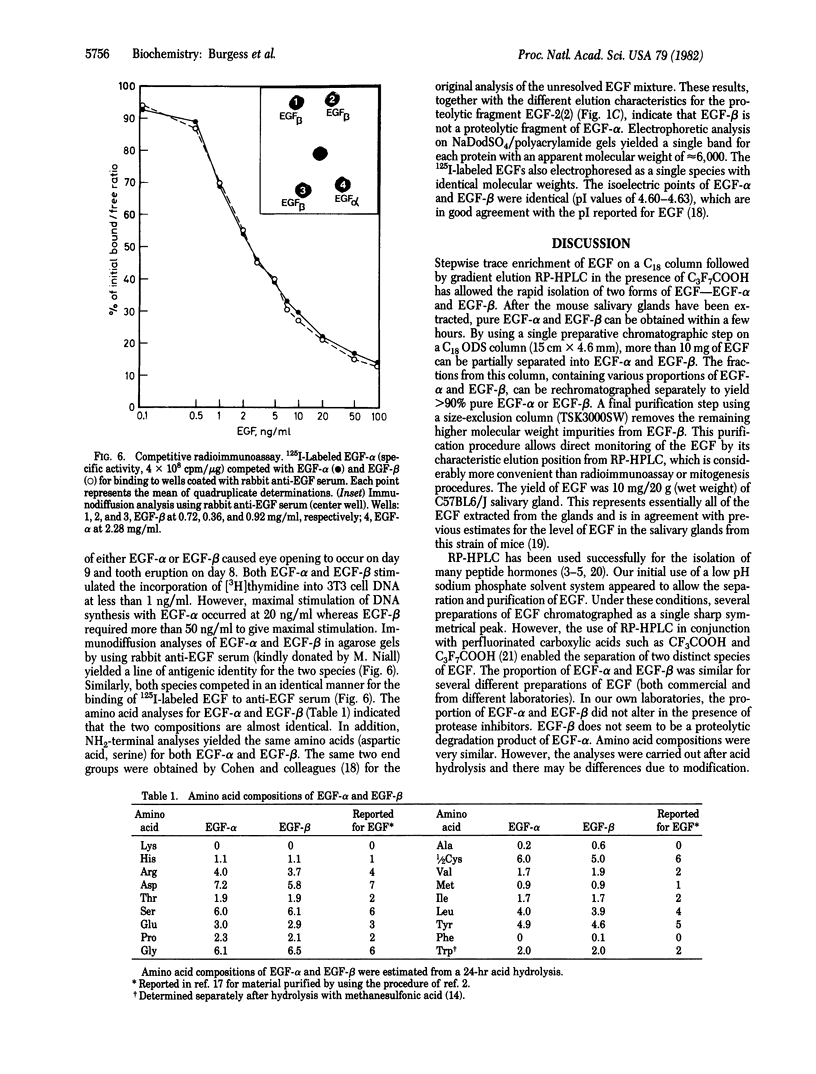
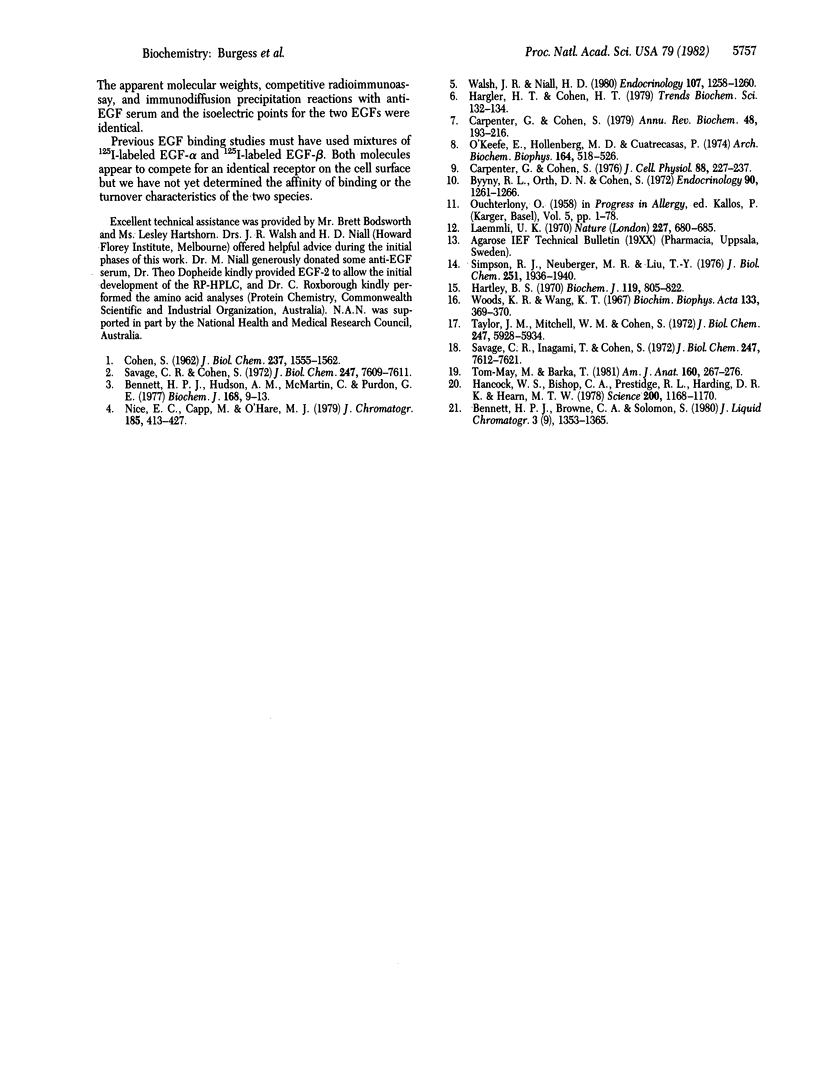
Images in this article
Selected References
These references are in PubMed. This may not be the complete list of references from this article.
- Bennett H. P., Hudson A. M., McMartin C., Purdon G. E. Use of octadecasilyl-silica for the extraction and purification of peptides in biological samples. Application to the identification of circulating metabolites of corticotropin-(1-24)-tetracosapeptide and somatostatin in vivo. Biochem J. 1977 Oct 15;168(1):9–13. doi: 10.1042/bj1680009. [DOI] [PMC free article] [PubMed] [Google Scholar]
- Byyny R. L., Orth D. N., Cohen S. Radioimmunoassay of epidermal growth factor. Endocrinology. 1972 May;90(5):1261–1266. doi: 10.1210/endo-90-5-1261. [DOI] [PubMed] [Google Scholar]
- COHEN S. Isolation of a mouse submaxillary gland protein accelerating incisor eruption and eyelid opening in the new-born animal. J Biol Chem. 1962 May;237:1555–1562. [PubMed] [Google Scholar]
- Carpenter G., Cohen S. Epidermal growth factor. Annu Rev Biochem. 1979;48:193–216. doi: 10.1146/annurev.bi.48.070179.001205. [DOI] [PubMed] [Google Scholar]
- Carpenter G., Cohen S. Human epidermal growth factor and the proliferation of human fibroblasts. J Cell Physiol. 1976 Jun;88(2):227–237. doi: 10.1002/jcp.1040880212. [DOI] [PubMed] [Google Scholar]
- Hancock W. S., Bishop C. A., Prestidge R. L., Harding D. R., Hearn M. T. Reversed-phase, high-pressure liquid chromatography of peptides and proteins with ion-pairing reagents. Science. 1978 Jun 9;200(4346):1168–1170. doi: 10.1126/science.206966. [DOI] [PubMed] [Google Scholar]
- Hartley B. S. Strategy and tactics in protein chemistry. Biochem J. 1970 Oct;119(5):805–822. doi: 10.1042/bj1190805f. [DOI] [PMC free article] [PubMed] [Google Scholar]
- Laemmli U. K. Cleavage of structural proteins during the assembly of the head of bacteriophage T4. Nature. 1970 Aug 15;227(5259):680–685. doi: 10.1038/227680a0. [DOI] [PubMed] [Google Scholar]
- Nice E. C., Capp M., O'Hare M. J. Use of hydrophobic interaction methods in the isolation of proteins from endocrine and paraendocrine tissues and cells by high-performance liquid chromatography. J Chromatogr. 1979 Dec 20;185:413–427. doi: 10.1016/s0021-9673(00)85618-6. [DOI] [PubMed] [Google Scholar]
- O'Keefe E., Hollenberg M. D., Cuatrecasas P. Epidermal growth factor. Characteristics of specific binding in membranes from liver, placenta, and other target tissues. Arch Biochem Biophys. 1974 Oct;164(2):518–526. doi: 10.1016/0003-9861(74)90062-9. [DOI] [PubMed] [Google Scholar]
- OUCHTERLONY O. Diffusion-in-gel methods for immunological analysis. Prog Allergy. 1958;5:1–78. [PubMed] [Google Scholar]
- Savage C. R., Jr, Cohen S. Epidermal growth factor and a new derivative. Rapid isolation procedures and biological and chemical characterization. J Biol Chem. 1972 Dec 10;247(23):7609–7611. [PubMed] [Google Scholar]
- Savage C. R., Jr, Inagami T., Cohen S. The primary structure of epidermal growth factor. J Biol Chem. 1972 Dec 10;247(23):7612–7621. [PubMed] [Google Scholar]
- Simpson R. J., Neuberger M. R., Liu T. Y. Complete amino acid analysis of proteins from a single hydrolysate. J Biol Chem. 1976 Apr 10;251(7):1936–1940. [PubMed] [Google Scholar]
- Taylor J. M., Mitchell W. M., Cohen S. Epidermal growth factor. Physical and chemical properties. J Biol Chem. 1972 Sep 25;247(18):5928–5934. [PubMed] [Google Scholar]
- Tom-Moy M., Barka T. Epidermal growth factor in the submandibular glands of inbred mice. Am J Anat. 1981 Mar;160(3):267–276. doi: 10.1002/aja.1001600305. [DOI] [PubMed] [Google Scholar]
- Walsh J. R., Niall H. D. Use of an octadecylsilica purification method minimizes proteolysis during isolation of porcine and rat relaxins. Endocrinology. 1980 Oct;107(4):1258–1260. doi: 10.1210/endo-107-4-1258. [DOI] [PubMed] [Google Scholar]
- Woods K. R., Wang K. T. Separation of dansyl-amino acids by polyamide layer chromatography. Biochim Biophys Acta. 1967 Feb 21;133(2):369–370. doi: 10.1016/0005-2795(67)90078-5. [DOI] [PubMed] [Google Scholar]



